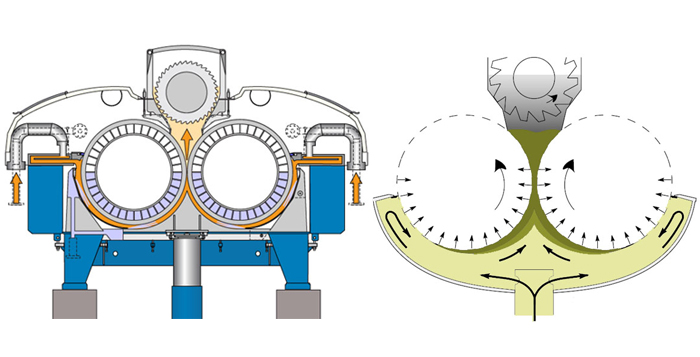ASMG series twin roll press
ASMG series twin roll press working principle
The twin-roller press uses the pressing principle to complete the entire work process. The slurry is pumped into the horn-shaped dewatering zone composed of the press roll of the twin-roller and the tank body. Due to the certain pressure generated by the slurry, the filter is dehydrated by the porous roller filter plate and discharged through the openings at both ends of the roller. A continuous slurry layer is formed on the roll surface. As the press roll rotates, the concentration of the slurry gradually increases with the rotation of the press roll, which can reach about 10% (or the slurry is in contact with the washing liquid when the displacement zone is reached, and the original filtrate in the slurry is replaced, and this displacement is always performed. Until the slurry enters the press area). The slurry continues to enter the pressing zone between the two press rolls as the press rolls rotate, and the slurry concentration is further increased by press dewatering, up to about 30%. The pulp cake formed in the press zone between the twin rolls can be peeled off from the roll surface by two sets of scrapers, into the discharge spiral, and then shredded by the crushing screw and discharged out of the twin roll press.
Types of ASMG series twin roll press
A type twin roll press
It is suitable for slurry with a beating degree of 25~35oSR and poor water filtration. The slurry starts to filter out black liquor from the tank, thus achieving the purpose of high pulping concentration. When the slurry concentration is stable, the feed pressure fluctuation is less than 3 kPa, the slurry concentration is low (3%~4%), and the slurry has less than 4%, the A-type twin-roller is used. Slurry, wheat straw, etc.

B type twin roll press
It is suitable for slurry with a beating degree of 15~25oSR and high water filtration. The slurry part is dehydrated by the following pressure, most of which is squeezed out of the black liquor through the middle two rolls, and the pulping concentration is lower, which is 2%~3% lower than that of the A type twin roll press, but the slurry is fed from the bottom. It is not easy to leave the slurry and block the tank. The slurry concentration is unstable, the feed pressure fluctuation is higher than 3kPa, but it must not exceed 20kPa, the slurry concentration is high (6%~10%), and the slurry has not too many knots (up to 6%).
When selecting a twin roll press, it must be selected according to the type of pulp, the degree of beating, the concentration of the slurry, the concentration of the slurry, the fluctuation of the feed pressure, the specific gravity of the pitch, etc. If the model is not correct, the slurry with a lower degree of beating is selected. The A-type twin roll press is used to filter out the black liquor from the tank. The concentration reaches 20%~30% instantaneously. The top of the A-type twin roll press (the lower part of the scraper) will cause blockage. The concentration reached 60% and even lifted the roller. Although the black liquor can also penetrate the slurry, in severe cases, all the slurry pipes are blocked and the twin-roller is destroyed. If the slurry with lower slurry concentration is B-type twin roll press, the slurry is fed from the bottom, and the slurry is rarely dehydrated by the above pressure. Most of the slurry is filtered through the middle two rolls to filter out the black liquor. The slurry concentration is low, and it is difficult to increase the concentration to 25% or more in the case where the slurry concentration is less than 4%.
Therefore, the A-type twin roll press is required to have a stable slurry concentration, small fluctuations in the feed pressure, and a lower slurry concentration; the B-type twin roll press can be appropriately relaxed, but the slurry concentration is low. It is difficult to achieve a pulping concentration of more than 30%.

